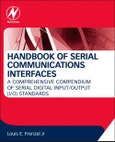With this book you will learn:
- The most widely used serial interfaces - How to select the best serial interface for a specific application or design - The trade-offs between data rate and distance (length or range) - The operation and benefits of serial data transmission - The most common media used for serial data transmission
Please Note: This is an On Demand product, delivery may take up to 11 working days after payment has been received.
Table of Contents
An introduction to Serial I/O communications; Serial I/O Primer: A Short Course in Data Communications and Networking; Selecting an Appropriate Interface; 1-wire; AS-i bus; Bit bus; C-Bus; CAN; DMX512; FlexRay; Foundation Fieldbus; HART; I2C; IO-LINK; I2S; LIN; M-bus; Microwire; MIDI; MIL-STD-1553; MODBUS; OBD II; PMBus; Profibus; RS-232; RS-422; RS-423; RS-485; SMBus; T1/E1; Ethernet (wire versions); Firewire; JTAG; MOST; SPI; USB; CAUI; CEI-28G; CPRI; DisplayPort; Ethernet (fiber versions); Fibre Channel; HDMI; Hypertransport; Infiniband; JESD204B; Kandou bus; Lightening; LVDS; MIPI-M-PHY; MHL; OTN; PCIe; Passive Optical Networks; Rapid I/O; SAS; Serial ATA; Serial Digital Interface; SONET/SDH; Thunderbolt; XAUI; Testing Considerations; Broadband Interfaces; DOCSIS; DSL; G3-PLC; G.hn; HomePlug; MoCA; PRIME; X10; Wireless Interfaces; 802.15.4; Bluetooth; DECT; EnOcean; ISA100-11a; ISM band; NFC; Ultra wideband; Wi-Fi; WirelessHART; ZigBee; Z-Wave.








